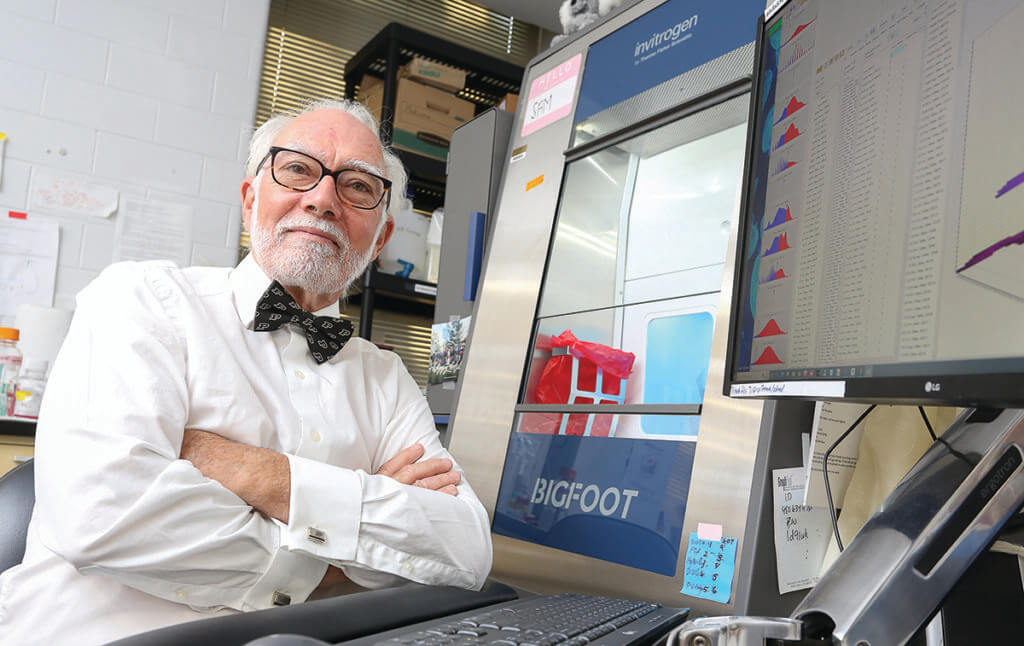Purdue University Cytometry Laboratories Aim to Develop Portable Toxin and Pathogen Detection Device

An estimated 48 million people in the United States experience foodborne illness each year, according to the Centers for Disease Control and Prevention. Of those, 128,000 cases require hospitalization and 3,000 result in death. A 2010 report published by the Produce Safety Project estimated that foodborne illnesses cost $152 billion in medical expenses, lost productivity and business, lawsuits and compromised branding.
A research team at the Purdue University Cytometry Laboratories, headed by Dr. J. Paul Robinson, Distinguished Professor of Cytometry in the College of Veterinary Medicine’s Department of Basic Medical Sciences, and professor of biomedical engineering in Purdue’s Weldon School of Biomedical Engineering, is working on a number of separate but inter-related projects funded by grants from the USDA to develop rapid diagnostics for pathogen detection, food safety and organism identification.
Detection of these pathogens is fundamental to identifying and minimizing foodborne disease outbreaks. Laser induced breakdown spectroscopy, a laser-based technique used to detect and analyze the chemical and physical characteristics of cells, can measure toxins and pathogens in food that cause food-related illnesses such as botulism, Salmonella sp., or E. coli. One of the lab’s primary goals is to develop technologies that reduce the time and expense involved in detecting pathogens and toxins in food. For example, portable detection systems would enable farmers to identify and treat toxins in grain before it gets mixed with other grains in a silo, contaminating the entire harvest and potentially entering the food system.
“The current standard of laboratory detection technologies requires complex and expensive equipment,” said Dr. Robinson. “The food distribution network is vast. Food goes through manufacturing, to the store, to a restaurant or home. The USDA is very keen on developing low-cost rapid detection technologies that are easy to use.”
The tests being developed in the Cytometry Laboratories are similar to the COVID-19 rapid tests that users conduct at home. The research team has developed chemistries that test a single sample for multiple antigens or reagents concurrently. These multiplex assays typically require a few days in the lab to produce results. The goal is to develop portable tests that could deliver results in minutes.
One such project, funded by the Indiana Corn Growers Association, is geared toward identifying fungi in corn and wheat. For that project, Dr. Robinson is collaborating with Dr. Euiwon Bae, senior research scientist in the College of Mechanical Engineering and Dr. Bartek Rajwa, associate research professor in the Bindley Bioscience Center.
“Dr. Bae brings the ability to build mechanical devices and Dr. Rajwa brings the informatics and statistical analysis expertise necessary to implement complex classification algorithms,” Dr. Robinson said. “This work requires an interdisciplinary approach.”
Dr. Bae is leading an effort to develop cell phone-based devices for detection that would report results and tag them with a GPS coordinate to identify the location of the collected sample. Portable diagnostic testing would save the food industry millions in wasted product while also preventing foodborne illnesses, particularly for regions of the world such as Africa where the toxins often go undetected and food is harvested and produced, resulting in widespread illness.
“When we have portability, we have the power of instant knowledge and instant access,” Dr. Robinson said. “It could be a produce store in Indiana, a cheese farm in Switzerland or a grain distribution site in Kenya. Rapid detection of toxins or pathogens in food will reduce foodborne diseases. Whether the contamination is intentional or unintentional, we need to be able to quickly identify it, often on-site. It’s just not always practical to take samples, send them to a central lab and wait to receive the results in a few days.”
The Importance of Authentication
Another aspect of Dr. Robinson’s center is work driven by Dr. Bartek Rajwa and is focused on food authentication. When a bottle claims it is 100% extra virgin olive oil, meaning it’s unadulterated oil from olives using no chemicals, can consumers trust the label is accurate?
“Food can be contaminated by many things, not only toxins,” Dr. Rajwa said. “Sometimes people intentionally contaminate food to change its properties. We are developing a technology to determine whether a product is pure or not. Does it come from the particular region it claims? Has it been contaminated? Has it been mixed with something else?”
When products are manufactured in bulk, they can be tested in bulk before they are distributed. If the product is found to be contaminated before it enters the food stream, it can be dealt with at the factory. Dr. Robinson points out the 2008 milk scandal in China where a company producing infant formula adulterated its product with the chemical melamine to boost the nitrogen content of the diluted milk in order to pass quality control testing. The contaminated formula resulted in widespread kidney damage among infants. Pets also are at risk from potential food contamination. Research documented cases in 2004 and 2007 of melamine and cyanuric acid contamination of pet food that resulted in fatal outbreaks of pet food-associated renal failure in several cats and dogs. Similar international contamination of food is also possible as an act of biological warfare, something the lab’s rapid tests could be used to detect as well. These circumstances point to the One Health implications of Dr. Robinson’s work as a means of providing for the safety of both people and animals.
Safety of troops is another concern. “When you have troops stationed in other countries, you don’t necessarily ship all the food to them, you source food locally,” Dr. Robinson said. “When you local source, you want to be able to test that the food given to the troops is safe.”
Broader Applications
Although the lab is currently focused on detection of foodborne illnesses and toxins, the portable test technology has multiple potential applications, particularly for the medical field.
Early in the COVID-19 pandemic, some ICU patients requiring ventilators were exhibiting aggressive immune system responses known as cytokine storms. Cytokines are small molecules made mostly by white blood cells that balance responses of the immune system to bacteria and viruses. When the immune system overreacts, cytokines can be overproduced.
“It was documented in the published literature that people dying from COVID-19 were having these huge inflammatory responses,” Dr. Robinson said. “Overproduction of cytokines can damage primary organs. I suggested we use the rapid test we were developing for the USDA and see if it could measure the cytokine IL-6.”
While medications exist to treat a cytokine storm, the condition must first be diagnosed, a process that typically takes a day and a half in a traditional laboratory setting. That’s where rapid portable tests that can be completed within minutes become critical to patient care.
“Our portable test could measure IL-6 in about 15 to 20 minutes,” Dr. Robinson said. “Once the physician knows the patient has a high cytokine response, they know what to treat. It takes out the guesswork.”
Just as the portability of cellular phones have transformed the way people live and work, Dr. Robinson envisions the development of portable diagnostic tests having a similar impact. Low-cost point-of-care medical diagnostic technologies have tremendous potential to revolutionize access to health care in resource-limited countries or remote areas with minimal health care infrastructure.
Dr. Robinson, a pioneer in the field of cytometry, established the nonprofit Cytometry for Life (cytometryforlife.org) program in 2006 to provide affordable battery-operated portable testing devices for AIDS patients in Africa and now focuses on training and education for young scientists. The lab’s current focus on detection of food toxins and pathogens is just the latest in his decades-long career using cytometry to develop diagnostics.
“The work never stops,” Dr. Robinson said. “Every solution you create provides the opportunity to solve another problem.”

